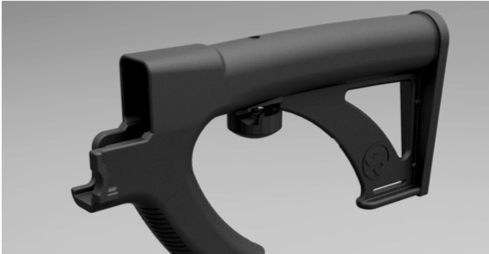How Does the New Bump Fire Stock Classification Affect Bump Stock?
* Repost from the National Pawnbroker – Spring 2019 Edition *
By Philip D. Milks
Most, if not all, of the firearms industry is aware that the Bureau of Alcohol, Tobacco, Firearms and Explosives (“ATF”) recently determined that bump fire stocks and similar devices are now defined as “machine guns”[1]under Federal law, effectively prohibiting consumers from owning them. However, the determination has implications beyond that of a simple consumer prohibition and affects all FFL types, including Type 2s. In this brief article we’ll review the process that resulted in the ATF determination and outline the effects it has on FFLs, including pawn brokers and others dealing in the secondhand market.
As an initial matter, let’s review ATF’s responsibility with respect to “approval” of firearms and firearm parts.
Manufacturers of firearms or firearm parts are not required to seek ATF’s approval on the design or function of the products they intend to manufacture and distribute. Regardless, manufacturers can, and often do, seek ATF’s opinion as to how they would classifya proposed product.[2] As such, when you see “ATF approved” or similar phrases, it generally means that ATF has classified something in a manner favorable to a manufacturer seeking to sell something into a particular market.[3] Thus, the phrase is more a matter of marketing than anything else.
ATF had previously classified bump stocks and other similar devices on multiple occasions as firearm parts that were not regulated under either the Gun Control Act (“GCA”) or the National Firearms Act (“NFA”). The classification was due to the fact that only a single projectile is expelled for a single depression of the trigger by the trigger finger and that the device does not fire again “automatically”; i.e., more than one projectile for a single depression of the trigger by the trigger finger.
The tragic October 1, 2017 shooting in Las Vegas provided the impetus for ATF’s reclassification of bump stocks and revision of the “machine gun” definition in the Federal Regulations. The investigation into the shooting revealed that the perpetrator had utilized multiple semiautomatic firearms with bump fire stocks attached to them. Almost immediately, there were calls for action from multiple sources for Congress and/or ATF to outright ban bump fire stocks or to impose additional restrictions upon them.
On March 29, 2018, the ATF, at the direction of the Trump Administration, published a Notice of Proposed Rulemaking which sought to “clarify that ‘bump fire’ stocks, slide-fire devices, and devices with certain similar characteristics (bump-stock-type devices) are ‘machineguns’ as defined by the National Firearms Act of 1934 (NFA) and the Gun Control Act of 1968 (GCA), because such devices allow a shooter of a semiautomatic firearm to initiate a continuous firing cycle with a single pull of the trigger.”[4] After a comment period and review of comments submitted by the public the Acting Attorney General announced the new rule on December 18, 2018 and ATF published its Final Rule on December 26, 2018. The Final Rule re-defined “machine guns” in the Federal Regulations to include bump fire stocks and other similar devices[5]and takes effect March 26, 2019.
How Does the New Bump Fire Stock Classification Affect Pawn Brokers?
Assuming the new rules actually go into effect on time and as planned (more on that in a moment), what effect does it have on pawn brokers and FFLs who deal in secondhand and used firearms? First and foremost, FFLs – including pawn brokers – are not exempted in any manner from the Final Rule. They cannot register their bump fire stocks as machine guns and none of their bump fire stocks or firearms with bump fire stocks are “grandfathered” in any manner. Those with experience with new “assault weapon” laws may ask why there is no grandfathering or amnesty period. Grandfathering or registration of machine guns in this circumstance is not legally possible due to 18 USC 922(o). In short, this is the section of the US Code which prohibits “post-86 machine guns.”[6]
Thus, any bump fire stocks in inventory would have to be destroyed or surrendered. Any firearms in inventory which have bump fire stocks should have the stock removed and destroyed or surrendered. A replacement stock may thereafter be placed on the firearm prior to sale. Perhaps most importantly, all employees who take in firearms should be made explicitly aware of the new restriction and should keep a very close eye on the stocks attached to used firearms which are taken into inventory.
However, as with most legislative and regulatory matters, the actual impact varies depending on a multitude of factors. First and foremost, lawsuits were immediately filed by multiple groups challenging the Final Rule. The lawsuits seek multiple avenues of relief, and if ultimately successful would result in the Final Rule being declared invalid and unenforceable. Should this happen, the “machine gun” definitions would remain as they were before the rulemaking and bump fire stocks would be completely legal as they have been.
Then there is a third possibility. In conjunction with at least one of the lawsuits a Temporary Restraining Order (“TRO”) against enforcement of the Final Rule was made. This is a matter ruled on by the court prior to trying the substantive causes of action against ATF. If the court decides upon the request for a TRO in the plaintiffs’ favor, then enforcement of the Final Rule would most likely be postponed pending the outcome of the litigation. If the court denies the request for the TRO, then enforcement of the Final Rule may begin immediately (March 26). Complicating matters further, regardless of which way the court rules upon the TRO there is the possibility for an opposite ruling on the core of the litigation. In other words, the court could decide the TRO in plaintiffs’ favor which would suspend enforcement of the Final Rule and then rule against plaintiffs which would make the “ban” effective. Or, the court could deny the TRO which would make all existing bump fire stocks “machine guns” (and thus require destruction of them on March 26) and then ultimately rule against ATF which would then render all bump fire stocks “not machine guns” (and their previous destruction therefore unnecessary).
Summarizing the above, to be safe all pawn brokers should assume the Final Rule will go into effect March 26 and prepare accordingly. You do not want unregistered “machine guns” in your possession after that date. However, everyone should be cognizant of the litigation; specifically how the court rules on the TRO as a ruling favorable to the industry would mean that bump fire stock inventory need not be destroyed.
[1]“Machinegun” is the term used in the statutes at 18 USC 921(a)(23) and 16 USC 5845(b) and the import regulations at 27 CFR 447.11 while “machine gun” is the term used in the GCA and NFA regulations at 27 CFR 478.11 and 27 CFR 479.11. The difference has no substantive effect.
[2]This is often done during the R&D process so as not to invest heavily in a product that would ultimately not be eligible for sale in a specific market segment, such as the muzzleloader market or GCA rifle market.
[3]E.g., an “ATF-approved” silencer on a muzzleloader means the manufacturer has obtained a favorable ATF classification that the silencer is not regulated under the NFA, or for purposes of this article, an “ATF-approved” stock means that ATF has evaluated the stock and determined it is not a “machine gun” regulated by the NFA.
[4]Bump-Stock-Type Devices, 83 Fed. Reg. 61, 13442 (March 29, 2018).
[5]It remains to be seen what else the revised definitions can encompass. Many observers suspect it can be extended to binary triggers and other devices.
[6]The restriction prohibits civilian ownership of machine guns manufactured after May 19, 1986 and also prohibits the free transfer of machine guns manufactured after that date, even amongst FFL/SOTs.
Other Articles of Interest







0 Comments